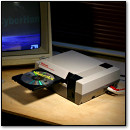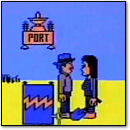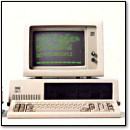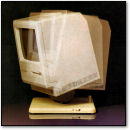Why American NES Controllers Can Kill You & Other Famicom Thoughts
Sunday, February 26th, 2006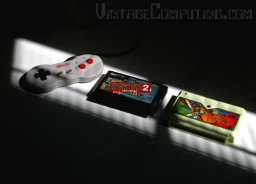 After playing my new AV Famicom and the 18 games that came with it for a few days, I have a few things to report. The first of which is that yes, I still love it. But if that were all I had to say, then this would be a boring article. Luckily, the other things are more interesting. For example, I am quickly falling for the Nintendo “dogbone” controller. It’s strange really; I’ve had one for years but never really gave it a good chance. I was biased immediately by the slanted A-B button arrangement, which I definitely do not like for playing Super Mario Bros. games (because I constantly hold down B with the tip of my thumb and use the ball of it to hit A and jump — the upward-slanted button line makes this play style awkward). But for every other game, it’s really comfortable. I now highly recommend getting one and giving it a chance if you haven’t already. My old US dogbone needs a good scrubbing and some new conductive rubber pads (I might have some left from an old controller repair kit somewhere) before it will be completely up to par. But once it is, I think it just might become my new favorite NES controller. I noticed something funny when comparing the Japanese dogbone and the US dogbone side to side. The Japanese dogbones have three foot controller cords, which is a pathetically short length by US standards. But it’s no big surprise; after all (or so I hear repeatedly) Japanese people all live in tiny apartments the size of my kitchen, so they’re never more than three feet away from their TV — even when taking a shower. Anything longer than three feet and the annual choking and tripping deaths in Japan would skyrocket. But hey, that’s Japan. In the US, we’re proud of tripping over our cords; it’s a matter of national pride. So how’s this for comparison: the cord on the US dogbone controller is eight feet long. No, not your standard six feet. Eight. Because of the three foot Japanese cord length, I think Nintendo of America decided to tack on another couple feet just out of spite. Either that, or Nintendo has a death wish for Americans.
After playing my new AV Famicom and the 18 games that came with it for a few days, I have a few things to report. The first of which is that yes, I still love it. But if that were all I had to say, then this would be a boring article. Luckily, the other things are more interesting. For example, I am quickly falling for the Nintendo “dogbone” controller. It’s strange really; I’ve had one for years but never really gave it a good chance. I was biased immediately by the slanted A-B button arrangement, which I definitely do not like for playing Super Mario Bros. games (because I constantly hold down B with the tip of my thumb and use the ball of it to hit A and jump — the upward-slanted button line makes this play style awkward). But for every other game, it’s really comfortable. I now highly recommend getting one and giving it a chance if you haven’t already. My old US dogbone needs a good scrubbing and some new conductive rubber pads (I might have some left from an old controller repair kit somewhere) before it will be completely up to par. But once it is, I think it just might become my new favorite NES controller. I noticed something funny when comparing the Japanese dogbone and the US dogbone side to side. The Japanese dogbones have three foot controller cords, which is a pathetically short length by US standards. But it’s no big surprise; after all (or so I hear repeatedly) Japanese people all live in tiny apartments the size of my kitchen, so they’re never more than three feet away from their TV — even when taking a shower. Anything longer than three feet and the annual choking and tripping deaths in Japan would skyrocket. But hey, that’s Japan. In the US, we’re proud of tripping over our cords; it’s a matter of national pride. So how’s this for comparison: the cord on the US dogbone controller is eight feet long. No, not your standard six feet. Eight. Because of the three foot Japanese cord length, I think Nintendo of America decided to tack on another couple feet just out of spite. Either that, or Nintendo has a death wish for Americans.
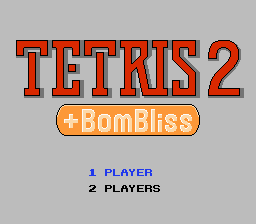 So what else is new? A few things. First of all, you must drop everything and play Tetris 2 + Bombliss. This cart contains my new official favorite version of Tetris, and it comes with a bonus Tetris-like game called Bombliss. This particular version of Tetris was never released in the US, so not many American gamers probably know of it (and no, it’s not Tengen’s Tetris). And for some reason, despite the number “2” in the title, it seems to be the same ‘ole Tetris that we know and love. This version was developed by Bulletproof Software, has great graphics, smooth gameplay and controls, and relatively relaxing music (instead of relentless, frantic Russian marches that typically make me want to jump off a bridge when under level-11 duress). Bombliss, also included, is a game played with Tetris-like pieces, except that some of the pieces contain — surprise — bombs. Every time you complete a horizontal line, all the bombs in the line explode. Your goal is to blow up everything on the play field (normal blocks included) by tactical bomb placement. Bombliss also has a puzzle mode, which is really addicting and worth playing. The game even lets you put in your initials and saves all your high scores to SRAM. All in all, I think Tetris 2 + Bombliss is a must-have for your Famicom collection. How do you get it? Well either track down an original copy of the cart (worth having), or perhaps find it through other means.
So what else is new? A few things. First of all, you must drop everything and play Tetris 2 + Bombliss. This cart contains my new official favorite version of Tetris, and it comes with a bonus Tetris-like game called Bombliss. This particular version of Tetris was never released in the US, so not many American gamers probably know of it (and no, it’s not Tengen’s Tetris). And for some reason, despite the number “2” in the title, it seems to be the same ‘ole Tetris that we know and love. This version was developed by Bulletproof Software, has great graphics, smooth gameplay and controls, and relatively relaxing music (instead of relentless, frantic Russian marches that typically make me want to jump off a bridge when under level-11 duress). Bombliss, also included, is a game played with Tetris-like pieces, except that some of the pieces contain — surprise — bombs. Every time you complete a horizontal line, all the bombs in the line explode. Your goal is to blow up everything on the play field (normal blocks included) by tactical bomb placement. Bombliss also has a puzzle mode, which is really addicting and worth playing. The game even lets you put in your initials and saves all your high scores to SRAM. All in all, I think Tetris 2 + Bombliss is a must-have for your Famicom collection. How do you get it? Well either track down an original copy of the cart (worth having), or perhaps find it through other means.
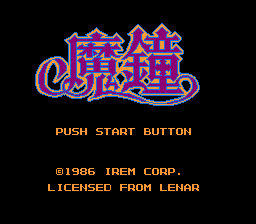 The last thing I have to report is a follow up on the couple Deadly Towers articles we had on here. It turns out that one of the 18 used games that came with my AV Famicom was none other than the Japanese version of Deadly Towers, known as Mashou (“Evil Bells”) over there. The only thing I really have to say is that I played it for a while, and it appears to be exactly the same as the US version, which is to say that it sucks just as bad. I’m exaggerating a bit, because I really like the charm of it, but of course, it’s no Zelda. Overall, the coolest thing about owning Mashou in cartridge form is that the cart has a nifty red LED built into it that lights up when you turn the system on (see white cart in picture above). For that reason alone, you must own it now. Run, don’t walk, to your nearest…Japan. Try not to trip on the way.
The last thing I have to report is a follow up on the couple Deadly Towers articles we had on here. It turns out that one of the 18 used games that came with my AV Famicom was none other than the Japanese version of Deadly Towers, known as Mashou (“Evil Bells”) over there. The only thing I really have to say is that I played it for a while, and it appears to be exactly the same as the US version, which is to say that it sucks just as bad. I’m exaggerating a bit, because I really like the charm of it, but of course, it’s no Zelda. Overall, the coolest thing about owning Mashou in cartridge form is that the cart has a nifty red LED built into it that lights up when you turn the system on (see white cart in picture above). For that reason alone, you must own it now. Run, don’t walk, to your nearest…Japan. Try not to trip on the way.
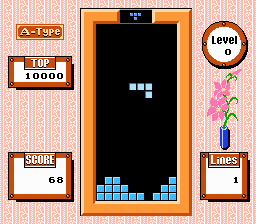
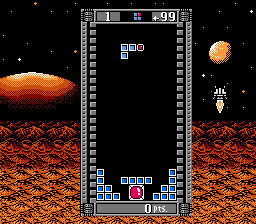
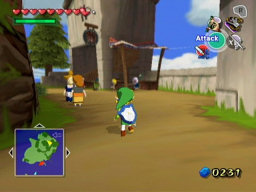 You may have noticed on other gaming blogs that yesterday (Feb 21st, 2006) was the 20th anniversary of the first release of The Legend of Zelda on the Famicom. I’ve been playing The Legend of Zelda: The Minish Cap this week by coincidence (an excellent game, by the way), and all this confluence of Zelda activity has gotten me thinking. Wouldn’t it be awesome to play a massively multi-player online role-playing game (MMORPG) set in the Zelda universe? Perhaps Nintendo could make a spiffy, slick 3D one with nice graphics for their upcoming Revolution console. If not, I’d be happy if some fans simply made a homebrew 2D, top-down MMORPG using A Link to the Past as a graphical framework. Either way, there would be some serious questions to address in such a game.
You may have noticed on other gaming blogs that yesterday (Feb 21st, 2006) was the 20th anniversary of the first release of The Legend of Zelda on the Famicom. I’ve been playing The Legend of Zelda: The Minish Cap this week by coincidence (an excellent game, by the way), and all this confluence of Zelda activity has gotten me thinking. Wouldn’t it be awesome to play a massively multi-player online role-playing game (MMORPG) set in the Zelda universe? Perhaps Nintendo could make a spiffy, slick 3D one with nice graphics for their upcoming Revolution console. If not, I’d be happy if some fans simply made a homebrew 2D, top-down MMORPG using A Link to the Past as a graphical framework. Either way, there would be some serious questions to address in such a game.
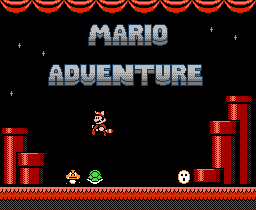 Just yesterday I had the opportunity to conduct an email interview DahrkDaiz, creator of the impressive hack
Just yesterday I had the opportunity to conduct an email interview DahrkDaiz, creator of the impressive hack 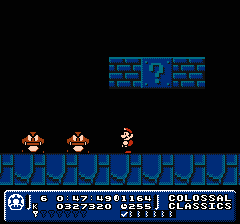 VC&G: What’s your favorite new feature of Mario Adventure? Also, what’s your favorite world in the game?
VC&G: What’s your favorite new feature of Mario Adventure? Also, what’s your favorite world in the game?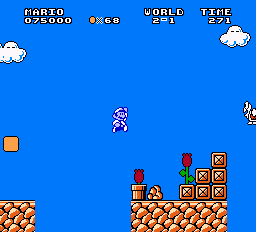 VC&G: Have you done any previous game hacking projects? If so, tell us about them.
VC&G: Have you done any previous game hacking projects? If so, tell us about them.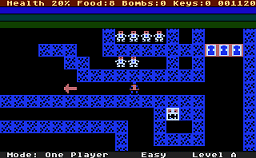
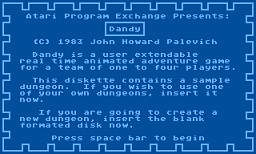
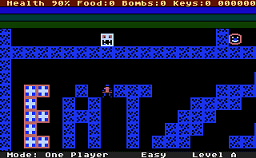
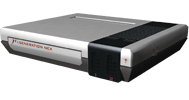 I received my
I received my 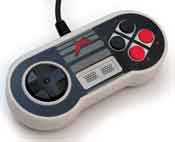 The compatibility problem brings me to another issue. I suspect that the Messiah guys didn’t do the hardware development on this machine. I think they probably repackaged the latest Asian gray-market Famicom clone, perhaps adding the built-in wireless controller functionality themselves in the process (supposedly its best selling point, although I have not tested it). If anyone can find some hardware design credits on their site (There are none in the system manual, only to the “President” and some marketing guys), let us all know. This whole thing stinks like fish. And speaking of the President, here’s an inspiring word from the man himself, direct from their May 23rd, 2005 press release:
The compatibility problem brings me to another issue. I suspect that the Messiah guys didn’t do the hardware development on this machine. I think they probably repackaged the latest Asian gray-market Famicom clone, perhaps adding the built-in wireless controller functionality themselves in the process (supposedly its best selling point, although I have not tested it). If anyone can find some hardware design credits on their site (There are none in the system manual, only to the “President” and some marketing guys), let us all know. This whole thing stinks like fish. And speaking of the President, here’s an inspiring word from the man himself, direct from their May 23rd, 2005 press release:

